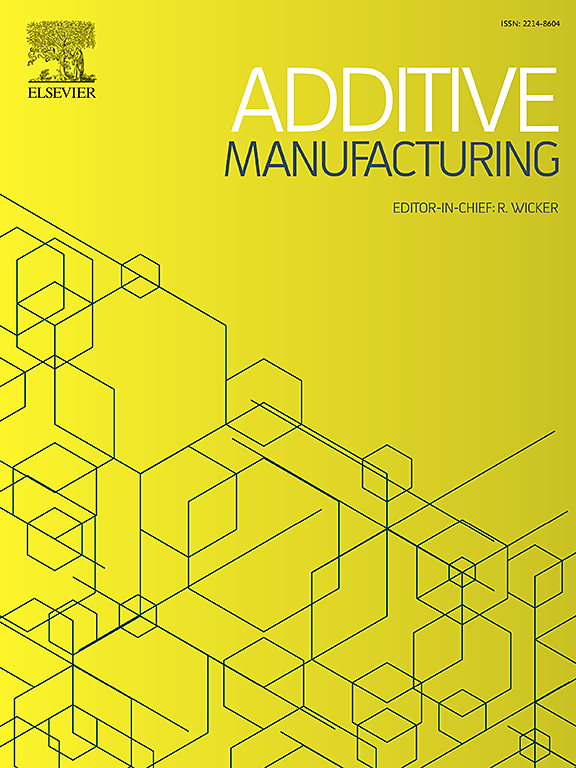Multi-scale numerical modeling of inductively coupled plasma spheroidization of refractory tungsten powders for additive manufacturing
IF 10.3
1区 工程技术
Q1 ENGINEERING, MANUFACTURING
引用次数: 0
Abstract
This study presents a multi-step, multi-scale modeling framework to address the complexities of particle spheroidization in inductively coupled plasma (ICP) processing of refractory tungsten powders, a precursor for refractory additive manufacturing. The framework integrates 2D axisymmetric and 3D non-transient multiphysics models to resolve plasma dynamics and turbulent flow fields within the ICP system. Additionally, a transient 3D Discrete Phase Model (DPM) was employed to predict particle flow behavior, heating, vaporization, and mass loss, while a 2D multiphase thermo-fluidic model at the particle scale simulated morphology evolution, including melting, vaporization, and sphericity transformations. The particle morphology evolution was governed by the interplay of surface tension, vaporization-induced recoil pressure, and non-uniform temperature distributions. Surface tension dominated the early melting phase, rapidly stabilizing smaller particles, while larger particles exhibited prolonged oscillations due to significant thermal gradients. Vaporization-induced recoil pressure dominated later stages, inducing localized deformation and altering droplet trajectories, with particles larger than 100 µm showing resistance to vaporization effects. The numerical results matched well with experimental observations, including the bimodal particle size distribution and post-spheroidization particle morphologies. The multi-scale multiphysics framework successfully predicted thermal flow, and morphological transformations providing a physics informed spheroidization pathways offering a robust platform for optimizing ICP-based spheroidization of refractory materials.
增材制造中难熔钨粉电感耦合等离子体球化多尺度数值模拟
本研究提出了一个多步骤、多尺度的建模框架,以解决电感耦合等离子体(ICP)处理难熔钨粉(难熔添加剂制造的前体)过程中颗粒球化的复杂性。该框架集成了二维轴对称和三维非瞬态多物理场模型,以解决ICP系统内的等离子体动力学和湍流流场。此外,采用瞬态三维离散相模型(DPM)预测颗粒流动行为、加热、汽化和质量损失,而在颗粒尺度上采用二维多相热流模型模拟形貌演变,包括熔化、汽化和球形转变。颗粒形貌的演变受表面张力、汽化反冲压力和非均匀温度分布的共同作用。表面张力主导了熔融早期阶段,小颗粒迅速稳定,而大颗粒由于显著的热梯度而表现出长时间的振荡。汽化引起的反冲压力在后期起主导作用,引起局部变形并改变液滴轨迹,大于100 µm的颗粒表现出对汽化效应的抵抗。数值结果与实验结果吻合较好,包括双峰粒度分布和球化后的颗粒形态。多尺度多物理场框架成功预测了热流和形态转变,提供了物理信息的球化路径,为优化基于icp的耐火材料球化提供了强大的平台。
本文章由计算机程序翻译,如有差异,请以英文原文为准。
求助全文
约1分钟内获得全文
求助全文
来源期刊

Additive manufacturing
Materials Science-General Materials Science
CiteScore
19.80
自引率
12.70%
发文量
648
审稿时长
35 days
期刊介绍:
Additive Manufacturing stands as a peer-reviewed journal dedicated to delivering high-quality research papers and reviews in the field of additive manufacturing, serving both academia and industry leaders. The journal's objective is to recognize the innovative essence of additive manufacturing and its diverse applications, providing a comprehensive overview of current developments and future prospects.
The transformative potential of additive manufacturing technologies in product design and manufacturing is poised to disrupt traditional approaches. In response to this paradigm shift, a distinctive and comprehensive publication outlet was essential. Additive Manufacturing fulfills this need, offering a platform for engineers, materials scientists, and practitioners across academia and various industries to document and share innovations in these evolving technologies.
 求助内容:
求助内容: 应助结果提醒方式:
应助结果提醒方式:


